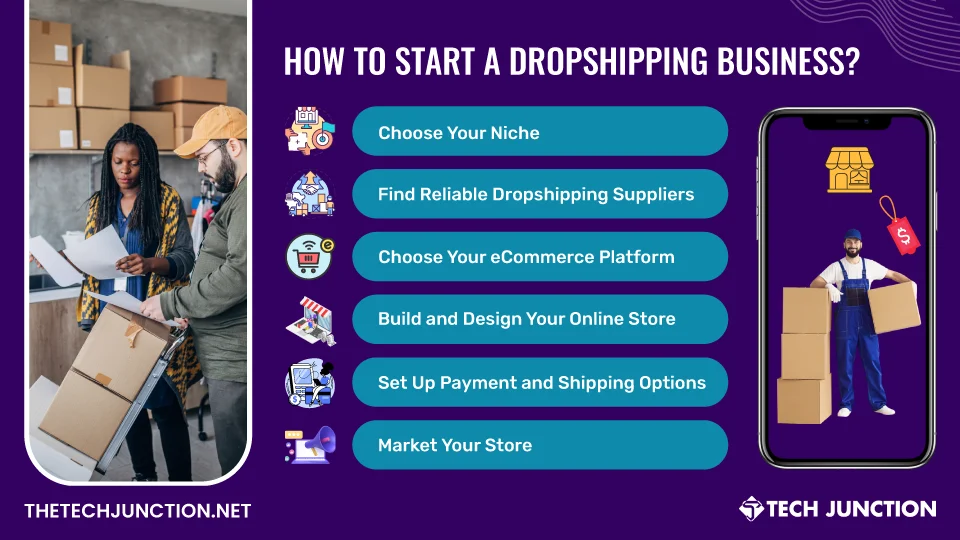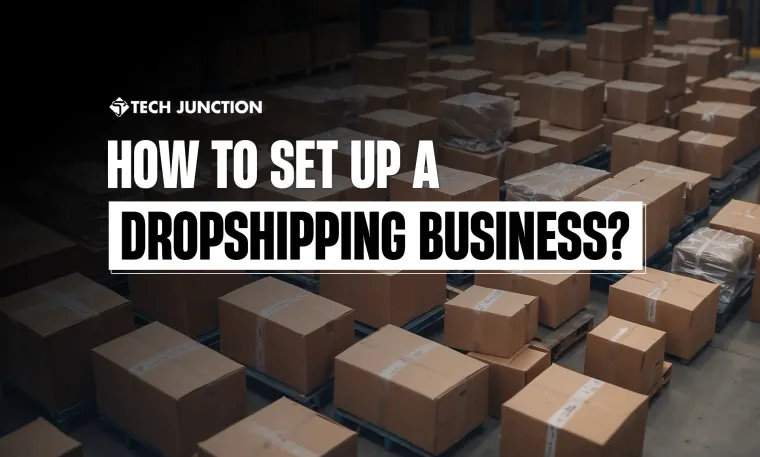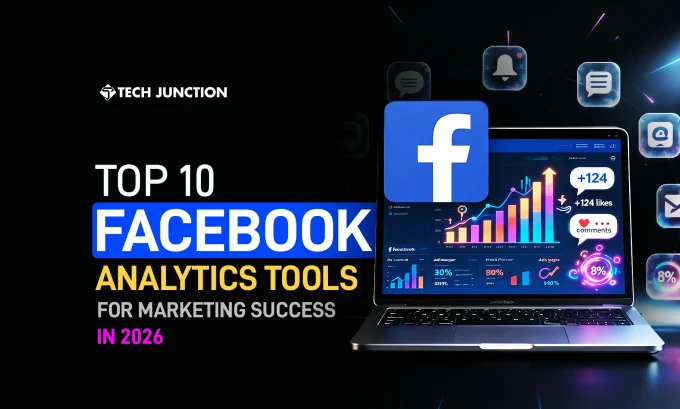Starting a dropshipping business offers a golden opportunity to break into eCommerce without the usual barriers of hefty upfront costs and inventory management. Imagine running a store where you don’t need to stock products, handle packaging, or manage shipping—yet you can sell thousands of items worldwide. In this guide, we’ll walk you through each step, from finding your niche to avoiding common pitfalls, so you can launch a successful drop shipping business and make your mark in the world of online retail.
What is Dropshipping?
Dropshipping is an eCommerce business model that allows you to sell products without holding any physical inventory. Instead of stocking products, you partner with best dropshipping suppliers who fulfill customer orders directly. Here’s how it works: when a customer places an order on your online store, you purchase the item from a third-party supplier (usually a wholesaler or manufacturer) who ships it directly to the customer. This way, you don’t have to worry about inventory management, warehousing, or shipping.
The allure of dropshipping lies in its low-risk setup and minimal initial investment. Since you only purchase products after making a sale, there’s no need to buy inventory upfront. This makes dropshipping an appealing option for beginners looking to start an online business with limited capital.
How to Start a Dropshipping Business?
Starting a dropshipping business requires careful planning and execution. Here’s a step-by-step guide to get you started:

Step 1: Choose Your Niche
Your niche is your store’s focus, so it’s important to choose one that aligns with your interests and has profitable potential in dropshipping business. To find a niche:
- Research Market Trends: Use tools like Google Trends to analyze current trends and popularity over time.
- Evaluate Profit Margins: Ensure there’s enough profit margin to cover the costs and still make a profit.
- Consider Competition: Look for niches with moderate competition, allowing you to establish a unique brand presence.
Step 2: Find Reliable Dropshipping Suppliers
The success of a dropshipping business heavily depends on the reliability of dropshipping suppliers, who fulfill your orders directly. Here’s how to find good suppliers:
- Supplier Directories: Sites like AliExpress, SaleHoo, and Oberlo can connect you with dropshipping-friendly suppliers.
- Evaluate Responsiveness and Reliability: Before partnering, communicate with suppliers to gauge their responsiveness. Look for suppliers with a solid track record of timely deliveries and good product quality.
- Order Samples: Test product quality by ordering samples before listing them on your store. This ensures you’re providing a quality experience to your customers.
Step 3: Choose Your eCommerce Platform
Once you have a niche and suppliers, it’s time to set up your online store for a dropshipping business. Popular platforms for dropshipping include:
- Shopify: Known for its ease of use and integrations with dropshipping apps like Oberlo, Shopify is a popular choice for beginners.
- WooCommerce: For those who prefer WordPress, WooCommerce offers flexibility, though it requires a bit more technical know-how.
- BigCommerce: This platform provides built-in tools for SEO and marketing, though it’s slightly more expensive.
Step 4: Build and Design Your Online Store
To attract and retain customers, your store needs to look professional and be user-friendly.
- Select a Theme: Choose a theme that suits your brand and provides a seamless shopping experience. Look for clean designs and mobile-responsive themes.
- Create Essential Pages: Include an “About Us” page to build trust, a “Contact Us” page for easy communication, and an FAQ section to answer common customer questions.
- Optimize Product Pages: Use high-quality images, detailed descriptions, and clear pricing to entice visitors. Make sure each page has keywords relevant to your niche to improve SEO.
Step 5: Set Up Payment and Shipping Options
Once your store is set up for your dropshipping business, configure payment gateways like PayPal or Stripe to accept payments. Shipping is another key aspect:
- Set Shipping Policies: Clearly outline shipping times and costs. Since dropshipping often involves international shipping, inform customers about potential wait times.
- Offer Multiple Payment Options: Providing diverse payment options can increase conversions by giving customers flexibility at checkout.
Step 6: Market Your Store
Marketing is essential to attracting customers and building brand awareness.
- Social Media Marketing: Platforms like Instagram, Facebook, and TikTok are excellent for showcasing products and connecting with your target audience. Consistent posting and engagement can drive organic traffic.
- Influencer Marketing: Collaborating with influencers can help get your products in front of a larger audience, driving brand credibility and trust.
- SEO and Content Marketing: Write blog posts related to your niche to increase organic traffic and improve search rankings. Keywords and SEO-optimized content can significantly enhance your store’s visibility.
Dropshipping Business Ideas
If you’re still unsure about your niche, here are a few trending dropshipping ideas for inspiration:
- Smart Home Gadgets: As smart homes become more popular, gadgets like WiFi-connected lights, smart plugs, security cameras, and voice-activated devices are in high demand.
- Outdoor Adventure Gear: Cater to nature enthusiasts with items like portable hammocks, waterproof backpacks, camping stoves, and compact survival kits.
- Customized Pet Accessories: Think personalized pet collars, stylish pet apparel, treat dispensers, and pet grooming tools. Pet owners love unique products that cater to their furry friends.
- Tech Accessories: With the rise in remote work and tech dependence, products like wireless chargers, ergonomic laptop stands, and noise-canceling headphones are great for tech-savvy customers.
- Home Gym Essentials: The fitness-at-home trend is still booming. Offer items like adjustable dumbbells, resistance bands, yoga mats, and compact treadmills.
- Eco-Friendly Kitchen Products: Offer sustainable items such as reusable food wraps, bamboo cutlery, silicone storage bags, and biodegradable sponges to environmentally conscious consumers.
- Jewelry: Minimalist and customized jewelry, such as initial necklaces, stackable rings, and dainty bracelets, is always popular and appeals to a wide range of consumers.
- Travel Accessories: With travel on the rise again, items like travel organizers, neck pillows, compact backpacks, and passport covers are ideal for the modern traveler.
When choosing products, ensure they are lightweight and easy to ship, as heavy items can lead to increased shipping costs and handling issues.
Common Mistakes to Avoid in Dropshipping Business
Launching a drop shipping business can be rewarding, but avoiding common mistakes can help you succeed faster:
Neglecting Product Quality: Poor quality products can lead to negative reviews and high return rates. Always vet your suppliers and order samples before adding products to your store.
- Ignoring Customer Service: Dropshipping often requires proactive customer service. Make sure to provide prompt responses and resolve issues effectively to build trust and reduce complaints.
- Overlooking Marketing: Many beginners assume that sales will come naturally. However, marketing is essential to driving traffic and generating sales. Invest in paid ads, SEO, and social media marketing to attract customers.
- Setting Unrealistic Expectations: It’s easy to get caught up in the hype of “easy money” from dropshipping, but patience and persistence are key. Don’t expect overnight success; instead, focus on continuous improvement and learning.
- Relying on a Single Supplier: If your supplier experiences delays or stock shortages, your business could be at risk. Diversify your supplier base or have backups to maintain consistent product availability.
Wrap Up
While dropshipping isn’t a get-rich-quick scheme, with dedication and a customer-focused approach, it can become a profitable business model. So, take the plunge, start exploring product ideas, and work towards making your dropshipping business a success!
The Tech Junction is the ultimate hub for all things technology. Whether you’re a tech enthusiast or simply curious about the ever-evolving world of technology, this is your go-to portal.















